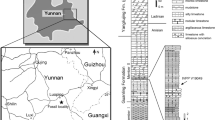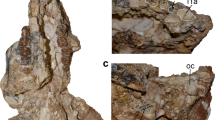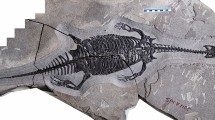Abstract
Modern pinnipeds (seals, sea lions and the walrus) are semi-aquatic, generally marine carnivores the limbs of which have been modified into flippers. Recent phylogenetic studies using morphological and molecular evidence support pinniped monophyly, and suggest a sister relationship with ursoids1,2 (for example bears) or musteloids3,4,5,6,7 (the clade that includes skunks, badgers, weasels and otters). Although the position of pinnipeds within modern carnivores appears moderately well resolved, fossil evidence of the morphological steps leading from a terrestrial ancestor to the modern marine forms has been weak or contentious. The earliest well-represented fossil pinniped is Enaliarctos, a marine form with flippers, which had appeared on the northwestern shores of North America by the early Miocene epoch8,9. Here we report the discovery of a nearly complete skeleton of a new semi-aquatic carnivore from an early Miocene lake deposit in Nunavut, Canada, that represents a morphological link in early pinniped evolution. The new taxon retains a long tail and the proportions of its fore- and hindlimbs are more similar to those of modern terrestrial carnivores than to modern pinnipeds. Morphological traits indicative of semi-aquatic adaptation include a forelimb with a prominent deltopectoral ridge on the humerus, a posterodorsally expanded scapula, a pelvis with relatively short ilium, a shortened femur and flattened phalanges, suggestive of webbing. The new fossil shows evidence of pinniped affinities and similarities to the early Oligocene Amphicticeps from Asia and the late Oligocene and Miocene Potamotherium from Europe. The discovery suggests that the evolution of pinnipeds included a freshwater transitional phase, and may support the hypothesis that the Arctic was an early centre of pinniped evolution.
This is a preview of subscription content, access via your institution
Access options
Subscribe to this journal
Receive 51 print issues and online access
$199.00 per year
only $3.90 per issue
Buy this article
- Purchase on Springer Link
- Instant access to full article PDF
Prices may be subject to local taxes which are calculated during checkout




Similar content being viewed by others
References
Hunt, R. M. & Barnes, L. G. Basicranial evidence for ursid affinity of the oldest pinnipeds. Proc. San Diego Soc. Nat. Hist. 29, 57–67 (1994)
Wang, X. M., McKenna, M. C. & Dashzeveg, D. Amphicticeps and Amphicynodon (Arctoidea, Carnivora) from Hsanda Gol Formation, central Mongolia, and phylogeny of basal arctoids with comments on zoogeography. Am. Mus. Novit. 3483, 1–57 (2005)
Arnason, U. et al. Pinniped phylogeny and a new hypothesis for their origin and dispersal. Mol. Phylogenet. Evol. 41, 345–354 (2006)
Wolsan, M. Phylogeny and classification of early European Mustelida (Mammalia: Carnivora). Acta Theriol. 38, 345–384 (1993)
Flynn, J. J., Finarelli, J. A., Zehr, S., Hsu, J. & Nedbal, M. A. Molecular phylogeny of the Carnivora (Mammalia): assessing the impact of increased sampling on resolving enigmatic relationships. Syst. Biol. 54, 317–337 (2005)
Sato, J. J. et al. Evidence from nuclear DNA sequences sheds light on the phylogenetic relationships of Pinnipedia: single origin with affinity to Musteloidea. Zoolog. Sci. 23, 125–146 (2006)
Finarelli, J. A total evidence phylogeny of the Arctoidea (Carnivora: Mammalia): relationships among basal taxa. J. Mammal. Evol. 15, 231–259 (2008)
Mitchell, E. & Tedford, R. H. The Enaliarctinae: a new group of extinct aquatic Carnivora and a consideration of the origin of the Otariidae. Bull. Am. Mus. Nat. Hist. 151, 203–284 (1973)
Berta, A., Ray, C. E. & Wyss, A. R. Skeleton of the oldest known pinniped, Enaliarctos mealsi . Science 244, 60–62 (1989)
Thewissen, J. G. M., Cooper, L. N., Clementz, M. T., Bajpai, S. & Tiwari, B. N. Whales originated from aquatic artiodactyls in the Eocene epoch of India. Nature 450, 1190–1194 (2007)
Jessberger, E. K. Ar-40-Ar-39 dating of the Haughton impact structure. Meteoritics 23, 233–234 (1988)
Sherlock, S. C. et al. Re-evaluating the age of the Haughton impact event. Meteor. Planet. Sci. 40, 1777–1787 (2005)
Whitlock, C. & Dawson, M. R. Pollen and vertebrates of the Early Neogene Haughton Formation, Devon Island, Arctic Canada. Arctic 43, 324–330 (1990)
Darwin, C. On the Origin of Species by Means of Natural Selection 6th edn 180 (Murray, 1880)
Demere, T. A., Berta, A. & Adam, P. J. Pinnipedimorph evolutionary biogeography. Bull. Am. Mus. Nat. Hist. 279, 32–76 (2003)
Savage, R. J. G. The anatomy of Potamotherium an Oligocene lutrine. Proc. Zool. Soc. Lond. 129, 151–244 (1957)
Baskin, J. A. in Evolution of Tertiary Mammals of North America. (eds Janis, C. M. & Jacobs, L. L.) 152–173 (Cambridge Univ. Press, 1998)
Schmidt-Kittler, N. Zur Stammesgeschichte der marderverwandten Raubtiergruppen (Musteloidea, Carnivora). Eclogae Geol. Helv. 74, 753–801 (1981)
Flynn, J. J., Neff, N. A. & Tedford, R. H. in The Phylogeny and Classification of the Tetrapods (ed. Benton, M. J.) 73–116 (Clarendon, 1988)
Tedford, R. H. Relationship of pinnipeds to other carnivores (Mammalia). Syst. Zool. 25, 363–374 (1976)
De Muizon, C. Les relations phylogénétiques des Lutrinae (Mustelidae, Mammalia). Geobios Mém. Spéc. 6, 259–277 (1982)
Fish, F. E. Association of propulsive swimming mode with behavior in river otters (Lutra canadensis). J. Mammal. 75, 989–997 (1994)
Fish, F. E. in Secondary Adaptation of Tetrapods to Life in Water (eds Mazin, J.-M. & de Buffrénil, D.) 261–287 (Pfeil, 2001)
Bebej, R. M. Swimming mode inferred from skeletal proportions in the fossil pinnipeds Enaliarctos and Allodesmus (Mammalia, Carnivora). J. Mammal. Evol. 10.1007/s10914-008-9099-1 (in the press)
Tedford, R. H. et al. in Late Cretaceous and Cenozoic Mammals of North America (ed. Woodburne, M. O.) 169–231 (Columbia Univ. Press, 2004)
Mörs, T. & Von Koenigswald, W. Potamotherium valletoni (Carnivora, Mammalia) aus dem Oberoligozän von Enspel im Westerwald. Senckenberg. Leth. 80, 257–273 (2000)
Orlov, J. A. Semantor macrurus (Ordo Pinnipedia, Fam. Semantoridae fam. nova) aus den Neogen-Ablagerungen Westsibiriens. Trudy Paleont. Inst. Akad. Nauk SSSR 2, 165–262 (1933)
Davies, J. L. The Pinnipedia: an essay in zoogeography. Geogr. Rev. 48, 474–493 (1958)
Matthew, W. D. Climate and evolution. Ann. NY Acad. Sci. 24, 171–318 (1915)
Swofford, D. L. PAUP*: Phylogenetic Analysis Using Parsimony (and Other Methods). Version 4. (Sinauer Associates, 1998)
Acknowledgements
NUFV 405 was prepared by M. A. Gilbert and A. Tabrum. M. A. Gilbert prepared Figs 3 and 4 and provided specimen photographs for skeletal reconstruction (Fig. 2). Figs 1 and 2 were prepared by M. A. Klingler with contributions from N.R., A. Tirabasso and M. A. Gilbert for Fig. 2. Surface scanning data (for example for Fig. 3) was collected by P. Bloskie. T. M. Ryan and A. Walker provided the computerized tomography of the basicranium of Puijila, B. Engesser lent specimens of Potamotherium, P. D. Gingerich provided information on limb measurements, and J. R. Wible provided discussion on ear regions and commented on the manuscript. This research was supported by a palaeontology permit from the Government of Nunavut, Department of Culture, Language, Elders and Youth (D. R. Stenton, J. Ross) and with the permission of the Qikiqtani Inuit Association, especially Grise Fiord. Guidance on Inuktitut words was given by S. Nattaq and S. Mike. J. Tungilik and T. Akulukjuk provided advice on pronunciation. Field research was supported by the Canadian Museum of Nature and the Carnegie Museum of Natural History. Collections support was provided by K. Shepherd and M. Feuerstack. Logistic and other support was provided by the Polar Continental Shelf Program (B. Hyrcyk, M. Bergmann, B. Hough, T. McConaghy, M. Kristjanson and the rest of the PCSP team) and the pilots of Kenn Borek Airlines. Student travel support was provided by the Northern Scientific Training Program (Canada). Our thanks are extended to our field crew members, M. A. Gilbert, J. C. Gosse, W. T. Mitchell, M. E. Lipman and especially E. M. Ross, who found the first bones of Puijila.
Author Contributions N.R. was field leader and was responsible for phylogenetic analysis and postcranial study; M.R.D. was responsible for craniodental anatomical description and systematic study; R.H.T. was responsible for phylogeny and palaeogeography.
Author information
Authors and Affiliations
Corresponding author
Supplementary information
Supplementary Information
This file contains Supplementary Figures SI-1-SI-2, with Legends, Supplementary Data, Supplementary Results, a Supplementary Table SI-1 and Supplementary References. (PDF 475 kb)
Rights and permissions
About this article
Cite this article
Rybczynski, N., Dawson, M. & Tedford, R. A semi-aquatic Arctic mammalian carnivore from the Miocene epoch and origin of Pinnipedia. Nature 458, 1021–1024 (2009). https://doi.org/10.1038/nature07985
Received:
Accepted:
Issue Date:
DOI: https://doi.org/10.1038/nature07985
This article is cited by
-
Attachment performance of the ectoparasitic seal louse Echinophthirius horridus
Communications Biology (2024)
-
Fossil brains provide evidence of underwater feeding in early seals
Communications Biology (2023)
-
Investigating the land-to-sea transition in carnivorans from the evolution of sacrum morphology in pinnipeds
Journal of Mammalian Evolution (2023)
-
Deciphering the evolutionary signatures of pinnipeds using novel genome sequences: The first genomes of Phoca largha, Callorhinus ursinus, and Eumetopias jubatus
Scientific Reports (2018)
-
A new carnivoran fauna from the late Oligocene of Hungary
Palaeobiodiversity and Palaeoenvironments (2018)
Comments
By submitting a comment you agree to abide by our Terms and Community Guidelines. If you find something abusive or that does not comply with our terms or guidelines please flag it as inappropriate.



